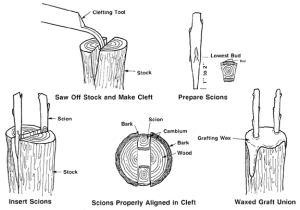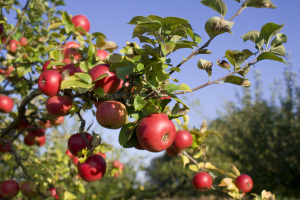
(http://www.wenatcheeconventioncenter.com/wp-content/uploads/2012/12/apple-capital.jpg)
Introduction
Malus domestica, the apple tree, is a member of the Rosaceae or Rose family. One of the most popular fruit trees in the world, and despite Wenatchee WA claiming to be the apple capital of the world the United States is actually the second largest producer of apples behind china. Which should come as no surprise that apples grow on a deciduous fruit tree that originates from central Asia. The Apple spread across the world making its mark on mankind as it went; the apple appears in many other religious and ancient parables, like the bible as the forbidden fruit, in fact the Latin word Malus means bad or evil. The American folk hero Johnny Appleseed was based on a real life person John Chapman; He was a traveling nurseryman that planted apples across the American Midwest, so settlers would have developing apple orchards when they reached their settlements.
Apples are popular in many uses when it comes eating and drinking, due to their long shelf life and how easy they are to prepare. Apples are used to make all kinds of food from sweet desserts like the All American Apple Pie to Savory Pork chops with Applesauce. Alcoholic Apple cider has recently started making a big comeback; in John Chapman day Apples were used almost exclusively to make cider because most apples were too tart or bitter to just eat. We’ve all heard that “an Apple a day keeps the doctor away” perhaps its because a medium sized apple contains about 80 calories and is high in fiber about 5 grams per fruit.
Propagation
If you live in USDA Hardiness Zones 5-9 you can grow an apple tree, but that doesn’t mean you can simply save the seeds from the next apple you eat. Although many propagation methods exist only a few work well for apple production, Apples are not true to seed meaning that the plant that grows from the seed will have inferior fruit than the parent tree. Apple Trees are also very difficult to root from a cutting, even if the cutting were to root the root system would not be able to support the plant. Apple trees can grow to 15-25 feet tall depending on whether or not the rootstock is dwarfing or not. Trees take 4-8 years before they will bear fruit, grafting and pruning can help speed up this process.
To successfully propagate an apple tree you’ll need a healthy rootstock, rootstocks are produced commercially by seed and mount layering but these methods can be slow and produce different kinds of rootstock. Tissue culture is a popular method of producing rootstocks; because advantage of using tissue culture is that the rootstocks produced will be genetically uniform as well as their size. When grafting it is critical to have compatible rootstocks and scions otherwise the graft will not take. Interstocks are sometimes used to help bridge the genetic gap between a scion and rootstock.
Grafting is the best way to propagate apple trees; because it ensures that the plant will have the desired traits the grower wants, whether it’s a dwarfing rootstock, disease resistance, or a specific cultivar. It also gives the grower the opportunity to grow multiple cultivars on the same tree if they wanted or change cultivars if they want this is referred to as “top working”. There are many grafting techniques such as cleft grafting, whip tongue grafting, side grafting, also budding, chip budding, and t-budding which is the similar but instead of a branch only a bud is required. Grafting is best done in spring when the trees bark is loose from April to early May, can also be done fall and winter. When grafting the rootstock should be at least 5 years old with 1 to 2 feet from the trunk and the graft.
 (http://www.ces.ncsu.edu/depts/hort/hil/gif/ag396-2.gif)
(http://www.ces.ncsu.edu/depts/hort/hil/gif/ag396-2.gif)
Grafting a step by step guide
Tools and Materials needed:
- Sharp Knife, make sure its clean, sterilize if possible
- Grafting tape or wax, or something similar that will cover the wound until it heals
- Scion wood
- Healthy rootstock
Step 1
Rootstock selection is critical; you want to make sure that the rootstock is compatible with the scion, you want to make sure that your graft won’t be too close to the ground or adventitious roots may form.
Step 2
You can collect your scion wood when the apple trees are dormant during the winter, You don’t want your scion wood to dry out, save them in a plastic bag wrapped in a moist paper towel stored in your refrigerators vegetable crisper. You want the scion wood to be ¼-1/2 inches in diameter, and between 2-8 inches long. You want your scion to have at least 3 buds and when you cut your scion word make sure that the cut is a little below the last bud give yourself enough room to make your grafting cut.
Step 3
Cut the top off of your rootstock to make room for your scion, then take your sharp knife and split the from the top down the middle about 1-1 ½ inches. The make a diagonal cut at the bottom of your scion then again on the opposite side this will make a “V” shape that can be wedged into your cleft cut on the root stock. It is very important to make sure that the cambial layers match up this is essential to ensure that the plants heal together to form a composite plant.
Step 4
Once the cambial layers are matched up you can cover the wound with either grafting wax or tape. This is to keep moisture in while keeping bacteria out, think of this like a plant Band-Aid, try not to wrap too tightly or you could risk restricting the growth.
Step 5
Check the graft as needed to ensure that the plant is healing together properly, it should take around 3-8 weeks to heal depending on temperature, once you notice the scion’s buds beginning to grow the graft should be healed. Once it’s healed you can graft new cultivars as soon as the next year by top working some of the branches.

(http://www.naturesedgegardencenter.com/wp-content/uploads/2014/04/Apple-Tree.jpg)
Conclusion
If you live in USDA hardiness zones 5-9 you can have your very own Apple tree, they are a great addition to any home because of its beautiful flowers and delicious fruit that will continue to comeback year after year. And with a little grafting knowledge and experience you can even change the cultivar or have multiple cultivars on the same tree. With your apples you can make Pies, juices, jams, and butter just to name a few. Plus the fruit’s long shelf life and many uses will make sure that nothing will go to waste.
Works Cited
- Hartmann, H. (2002). Plant propagation: Principles and practices (7th ed., pp. 729-730). Upper Saddle River, N.J.: Prentice Hall.
- Collett, L. (2011, January 1). About The Apple – Malus domestica. Retrieved November 6, 2014, from http://extension.oregonstate.edu/lincoln/sites/default/files/about_the_apple.lc_.2011.pdf
- Meloy, R. (n.d.). An Easy Method for Grafting Apple Trees. Retrieved November 6, 2014, from http://www.motherearthnews.com/organic-gardening/grafting-apple-trees.aspx#axzz3IOoDPiKA
- Hertz, L. (n.d.). Grafting and budding fruit trees. Retrieved November 6, 2014, from http://www.extension.umn.edu/garden/yard-garden/fruit/grafting-and-budding-fruit-trees/
- Richins Myers, V. (n.d.). Can You Really Grow Apples from Seeds? Retrieved November 6, 2014, from http://treesandshrubs.about.com/od/propagation/f/applesfromseed.htm